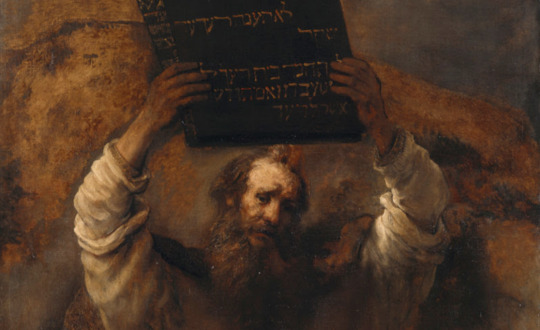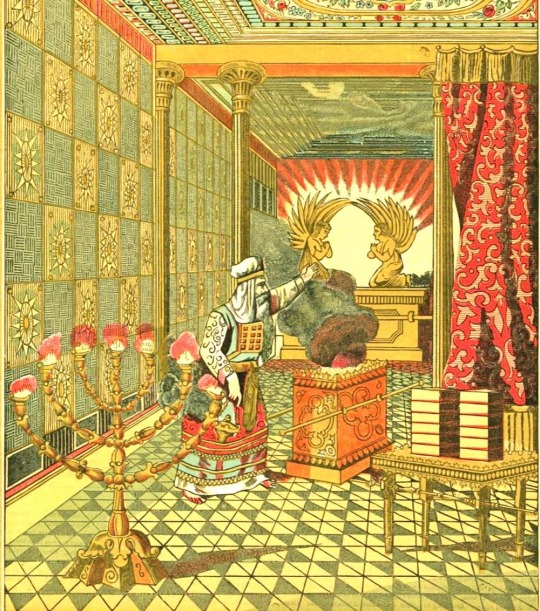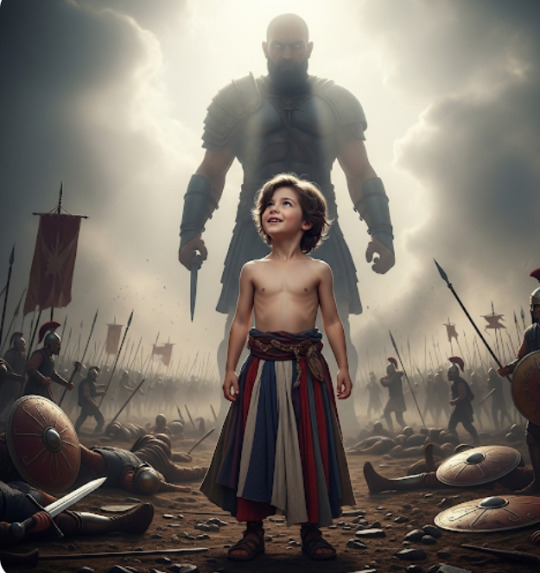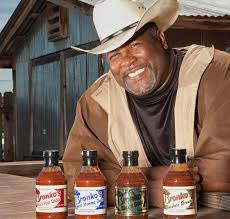#tetzaveh
Explore tagged Tumblr posts
Text
Parashat Tətzaveh: הַשֵּׁשׁ | hasheish
I am always thinking — worrying, even — about where stuff comes from. To get plain, undyed cloth with no particular embroidered ornamentation, you need all this vast apparatus of production, all these hours and hours of labor and years of learned skill. (There are few things as humbling as trying to spin thread even and fine enough to be woven into clothing using nothing more than a drop spindle and your own two hands.) I often read visions of idyllic, utopian futures where stuff just seems to pop magically into existence, as tho generated by a Star Trek replicator. No one has to harvest the fruit; no one has to lay sewage pipes; no one has to stitch together the pillowcases. But all of these things take work, and if you put that work out of mind, it’s all too easy to put the people who do that work out of mind as well. But without people doing that work, the work does not get done, and if the work does not get done, none of these things can exist.
In many of these divrei, I’ve explored words that are difficult to translate, either because they’re ambiguous in the Hebrew or because I want to freight them with mystical meaning. Not so this week; שֵׁשׁ | sheish tidily means “linen”.
Even so, there’s something curious about its presence in this week’s parashah. G-d commands Mosheh to make the holy garments of the high priest, the garments that are to be worn when ministering in and around G-d’s holy desert tent, and in Shəmot 28:5, we learn that these garments are to be made of אֶת־הַזָּהָב וְאֶת־הַתְּכֵֽלֶת וְאֶת־הָאַרְגָּמָן וְאֶת־תּוֹלַֽעַת הַשָּׁנִי וְאֶת־הַשֵּׁשׁ | et hazahav və’et hatəkhéilet və’et ha’argaman və’et tolá’at hashani və’et hasheish | “gold and blue and purple and worm-crimson and linen”. The Torah doesn’t specify what fibers are supposed to be dyed blue and purple and red, but rabbinic tradition is firm that those fibers were to be wool. Which is to say that the high priest’s holy clothes would have been made from a mixture of wool and linen, a mixture that is elsewhere explicitly prohibited by G-d.
There’s a lot one could say about this. I’ve written elsewhere about the idea of G-d as an all-containing Unity; perhaps drawing close to G-d requires relaxing divisions that are present elsewhere, edging towards a state of being where any one thing is every other thing at once. One could bring in the mystical narrative of tzimtzum — the idea that to make room for creation, G-d first had to shrink the Divine Presence and withdraw from the world — and Biblical notions of Holiness as dangerous (see, eg, Nadav and Avihu) to suggest that the commanded separation between wool and linen is a fence, a barricade, a staking out of room for material things to exist. (The first primordial acts of Creation were acts of division, separating light from darkness, upper waters from lower; there is a sense in which division is somehow necessary for creation, a sense in which there cannot meaningfully be an I unless there is also a not-I that I am distinguishable from.) But the high priest, in interposing between G-d and the Israelites, has to let down this fence at least a little bit, to relinquish, partly, Earthly existence in order to be able to commune with the numinous.
This is all very rich ground, and someday I may come back to it, but for once, I want to set the mysticism aside and talk materiality.
In descriptions of the priest’s clothing, linen often gets short shrift. People have a lot to say about the metal threads, about the brilliant and fussy dyes, but the linen, when it’s mentioned at all, tends to be glossed as “plain” or “simple”. If you look up pictures of the holy outfit, you’ll find a lot of attention paid to spectacular, eye-catching patterns and big bold washes of intense hues; you won’t find a lot of attention paid to the undyed flax fibers that are also there.
Here is what it takes to turn linen from a plant into a thread.
After the flax has grown — and note that agriculture, especially pre-industrial agriculture, is famously hard labor, so this is already eliding out a frightful amount of work — it must be pulled out of the earth — pulled and not cut with a scythe because you want to get some of the root system too to maximize the length of the available fibers. You must then partially dry the stalks to prepare them for retting. Retting is the process of letting the flax stalks sit in stagnant water so the pith swells and bursts, making room for bacteria to eat away the pectin that binds the bast fibers (the fibers that will ultimately be spun into linen thread) to the other parts of the plant. If you have big pools of standing water (which you must monitor, because if you let the retting process go too far, the bast fibers themselves will begin to decay), this process may only take a few weeks; if you’re in a drier climate (and the wildernesses of the Torah are not known for being particularly wet), you may have to rely on morning dew for the moisture in this process, which will take considerably longer.
Once the retting has gone far enough, you must then break up the stalks completely so the fibers can be extracted. The extraction itself is done by scutching the bundles of flax — striking them repeatedly with a wooden knife to essentially scrape away the woodier parts of the plant. You must then hackle the flax, combing it with a bed of nails to separate out any short or broken fibers, leaving only the long and sturdy bast. A really skilled team might get fifteen or so pounds of usable fibers from fifty pounds of grown flax; with less-skilled teams, you should expect to lose more along the way.
You are now ready to begin to spin. There are fewer conceptual steps to spinning — you take the fibers and spin them into thread — but what steps there are take a great deal of time: Before the invention of the spinning wheel (approximately fifteen centuries after the date of this text), spinning ate up somewhere north of 80\% of the total production time of a garment, including the time necessary to process the flax stalks beforehand and to weave, cut, and sew the garment behindhand. All that retting and scutching and hackling is just a drop in the bucket next to the endless painstaking labor of twisting fiber against fiber from the distaff to the spindle.
And then, of course, you do need to weave and cut and sew those fibers into fabric and into garments.
This is, to put it mildly, an awful lot of work. And this is what is described as plain linen, as simple linen. This is the boring unremarkable stuff.
I am always thinking — worrying, even — about where stuff comes from. To get plain, undyed cloth with no particular embroidered ornamentation, you need all this vast apparatus of production, all these hours and hours of labor and years of learned skill. (There are few things as humbling as trying to spin thread even and fine enough to be woven into clothing using nothing more than a drop spindle and your own two hands.) I often read visions of idyllic, utopian futures where stuff just seems to pop magically into existence, as tho generated by a Star Trek replicator. No one has to harvest the fruit; no one has to lay sewage pipes; no one has to stitch together the pillowcases. But all of these things take work, and if you put that work out of mind, it’s all too easy to put the people who do that work out of mind as well. But without people doing that work, the work does not get done, and if the work does not get done, none of these things can exist.
We look at the high priest, and are dazzled by the finery. Shəmot’s lavish descriptions beguile us with their sensual details. A panoply of colors swirls up from the text — and then plain, simple linen caps the list off, reminding us how staggeringly much human effort goes into making even the most unadorned things.
[This has been an installment of one-word Torah. You can read the whole series here.]
#one-word Torah#Torah commentary#Parashat Tətzaveh#tetzaveh#parashat hashavu'a#parsha#flax#textile production#A Collection of Unmitigated Pedantry has a great series on fiber production in the ancient world#which this cribs from a little bit#attn#briochebread#this one is for you
4 notes
·
View notes
Text
tonight in torah study: we learn about the transitive properties of holiness, sacrifices begin, and we try to solve a piece of clothing
8 notes
·
View notes
Text

SILENT TESTIMONY
This week’s parsha, Tetzaveh, is the only one in the Torah after the birth of Moses that does not mention his name. The Baal HaTurim attributes this to Moses’ plea to God on behalf of the Jewish people after the sin of the golden calf: “Now, if You will forgive their sin [well and good]; But if not, erase me now from Your book, which You have written.” The words of a tzaddik (saintly and wise individual) have power, and when Moses told God to erase him from the Torah, God did so by erasing Moses from Parsha Tetzaveh.
This seems like a punishment, which is odd because when Moses made that plea to God, it was coming from a place of great humility. Moses was willing to sacrifice himself to bring God’s mercy upon the Jewish people. In fact, his tactic worked and the people were saved. So why is Moses being punished?
Rabbi Yissocher Frand explains that the omission of Moses' name from Parsha Tetzaveh is not a punishment but rather a tribute to the most humble man who ever lived. Since every other parsha contains Moses’ name, the absence of it in Tetzaveh is felt. Rabbi Frand characterizes it as a “silent testimony” to Moses. But why is Tetzaveh the parsha where Moses’ name is absent? Rabbi Frand again invokes Moses’ humility. The parsha is about the Kohen Gadol (High Priest) and his clothing. Moses’ brother Aaron was the Kohen Gadol, and Moshe didn’t want to steal the limelight from his older brother.
Image: “Moses with the Ten Commandments” by Rembrandt, 1659 (detail)
8 notes
·
View notes
Text
youtube
Weekly Thought - Tetzaveh
Rabbi Benji
6 notes
·
View notes
Video
youtube
We are a time capsule of the D.N.A that preceded us. A poem for Parsha Tetzaveh by Rick Lupert. #torah #poetry #tetzaveh
Read along at https://jewishpoetry.net/ephod-for-thought-tetzaveh-aliyah-2/
0 notes
Text
Tetzaveh
I’m thinking about the burden of being a representative this week. Much of this Parsha is describing vestments of the priesthood. The fontlet and breastplates carved with distinction. Every aspect of the outfit laced with symbolism or the names of the sons of Israel so that Aharon can represent the community before Hashem. The burden of representing the people must fall so heavy, claiming that responsibility for saying, “this is who we are.” And it leads me to thinking about how members of minoritized communities are forced to do that every day. You’re not just a person – you are the representation of trans people. Your errors do not simply reflect on your but can confirm stereotypes, and further other people may judge you for the actions of your fellows and not your own. It feels especially ominous that this comes just before the golden calf. We do not see the mistakes of the Israelites yet, but they are coming, and we know how this story ends.
It's collectivism: Kol yisrael arevim zeh bazeh. How do we take responsibility for each other when we disagree? Or when we don’t want to claim association with another’s beliefs or actions? How can we be representatives for each other? What are the limits of being a community? How can we build coalitions when we know we don’t agree on everything, but are still working towards a common cause? What if we don’t agree with those elected to represent us? I think I've been left with more questions than answers but I think that's also life.
1 note
·
View note
Text
Parashat Tetzaveh (Ex.27:20-30:10) details the regal robe worn by Aaron, the first High Priest (Kohen Gadol).
The Hoshen Mishpat or Breastplate of Judgement was placed over his heart because he was found fit to minister to the needs of the nation.
Aaron humbly pursued peace and justice, fully understanding that the Will of God was all that mattered.
The garments of the High Priest evoked honor, nobility, beauty and the potential for bringing holiness to the physical realm.
The parsha also describes the altar of incense filling the sanctuary of the Tabernacle with clouds of qetoret (incense) a constant reminder of the clouds that surrounded Moses when he spoke with the Creator on Mt. Sinai.
Shabbat Shalom

#secular-jew#israel#jewish#judaism#israeli#jerusalem#diaspora#secular jew#secularjew#islam#parashat tetzaveh#Aaron#kohen Gadol#high priest
4 notes
·
View notes
Text
I went to an Orthodox school and it was a thing to memorize every single parasha. It's one of those things that never leaves you
Question to English-speaking diaspora Jews: How do you typically refer to books of the Tanach? Is it by their Hebrew name (e.g. Bereshit) or by their English-given name (e.g. Genesis)?
#bereishit noach lech-lecha vayera chayei sarah toldot vayeitzi vayishlach vayeshev miketz vayigash vayichi#shemot va'era bo beshalach yitro mishpatim teruma tetzaveh ki-tisa vayakhel pekudei#vayikra tzav shemini tazria metzora acharei-mot kedoshem emor behar-bechukotai#bamidbar nasso behalot'cha shlach korach chukat balak pinchus matot-ma'asei#devarim ve'etchanan ekev re'eh shoftim ki-tetzei ki-tavo netzavim vayelech ha'azinu vezot-habracha#can i have a lollipop now
157 notes
·
View notes
Text
"The Iron On." From the Book of Sirach, "The Manner of the Fern" 47: 2-7.

Next Sirach explores the most famous Jew ever, King David of Bethlehem. This is part 1 of 2 which begins with "the fat portion of the fellowship offering":
David
2 As the choice fat portion of the fellowship offering is reserved for the Lord, so David was chosen from among the Israelites. 3 He played with lions and bears as if they were lambs or little goats.
4 When he was still a boy, he killed a giant to rescue his people. He put a stone in his sling, took aim, and put an end to Goliath's bragging.
5 He prayed to the Lord, the Most High, and was given the strength to kill that famous soldier, so that the nations would have respect for the power of his people.
6 The people honored him for killing his tens of thousands, and when he was crowned king, they praised him for being chosen by the Lord. 7 He wiped out all his enemies and permanently crushed the Philistines, so that they never again became a threat.
The Fat Portion =609, םט, st, "a fragmented subtance." Fat is associated with the flavorful aspects of life. Any reference to fragments refers to the fact the entire Jewish library is composed of Mishnah, and they must not be read solely for the purposes of religion. All one needs to succeed as a keen and handsome being in every aspect of life is found within. Not all of it is a dirge.
As for the Fellowship Offering itself, the Torah for this is found in Tetzaveh:
“Consecrate those parts of the ordination ram that belong to Aaron and his sons: the breast that was waved and the thigh that was presented. 28 This is always to be the perpetual share from the Israelites for Aaron and his sons. It is the contribution the Israelites are to make to the Lord from their fellowship offerings."
The Values in Gematria are:
v. 27: Consecrate the ordination ram. The Number is 8390, ףגץ, "an iron on."
Anyone who has ever seen the new god, AKA the ordination ram jogging by or working out nearby at the gym knows what it means to be "ironed on." Jewish scriptures are not shy about this.
v. 28: This is the perpetual share. The Number is 8175, ףאעה, ephaa, "the sidelock."
The one we are waiting for must be as close to us as our sideburns. As we know the Torah forbids us to be without them.
As for the verses above the Numbers are:
David=718, ןיח, nih, "imagine, postulate."
v. 2-3: He played with lions as if they were little goats. All animal symbols in the Jewish religion refer to unenlightened and enlightened aspects of man's innate equipment. The ideal male boy is a goat, but they come in various sizes and shapes within the animal kingdom. David represents the best of all of them no matter the species.
The Number is 10986, קטחו, kitchu, "to set up or arrange the brotherhood."
No one conceives of lions as shepherds unless they refer to the Hebrew term lachish, which means "secular justice."
"The Hebrew name Lachish (לכיש) is interpreted as having a meaning related to "smitten," "striking," or "capturing". It is also associated with the idea of being "tenacious," "unyielding," or "impregnable," suggesting a strong and persistent nature."
v. 4: When he was still a boy, he killed a giant. The Number is 6042, סםב, samb, "to become something."
"In Hebrew, "samb" (סמ) can be understood as a shortened form or nickname, often related to the verb samach (סָמַךְ), which means "to support," "to lean on," or "to rely on". It can also be connected to the concept of "going together" or "being compact," stemming from the root sabab (צבב)."
The Kabbalah for this term actually means the giant Goliath came down to David's size, and David went up to his. Sooner or later, this happens to everyone.

v. 5: He prayed to the Lord and was given the strength to kill. The Number is 9518, ץהיח, tshehich, "You will talk about the regions on the other side of the thigh."
And how shall we talk about this?
v. 6-7: The people honored him for killing. The Number is 9960, צטס, cets, "the burgeoning blossom."
The final Gemara for the Big Talk is: םטףגץףאעה ןיחקטחוסםב ץהיחצטס, metafg etashpi'a nenichkitush amev tzchachach tzates, "The influence of the mother is the same as the influence of the father."
There is a term in Hebrew called sod, "the Hebrew word סוד (sod) generally means a gathering, assembly, or council, often involving a confidential or intimate setting. It can refer to a formal council, a group of friends, or even a group of schemers. The term also carries connotations of secrecy and exclusivity, especially when used in religious or prophetic contexts."
The ram offered during the Fat Portion alludes to the fact David was a sod, a single Ramboy, "Supreme in depth, a single man with all of the qualities of all the rabbis in the Torah." In modern terminology this a red ram, or a Rambam, "a noble sir."
This is the topic all fathers must have with their sons. It has little to do with sex, though how to handle one's wicky is of course a necessary discussion at some point. The "talk" should include stark terror of crystal meth and boys who spend too much time on their phones if ye are wise.
0 notes
Text
"The Leviathan." From the Book of Jeremiah, 11: 14.

God concludes his warnings about half-wits who pray but cannot attain to the unity of the human race, especially within the Holy City. Mankind's failures to address a few grand things render the rest into fodder. The end of wars, bullets, guns, climate change, poverty, and corruption, and that bullshit in and about Israel are among these:
14 "Jeremiah, don't pray to me or plead with me on behalf of these people. When they are in trouble and call to me for help, I will not listen to them.”
The Number is 7792, עזץב, azatzav, "say I'm sorry."
Saying sorry in the Torah is an extensive process.
From Tetzaveh:
10 “Bring the bull to the front of the tent of meeting, and Aaron and his sons shall lay their hands on its head. 11 Slaughter it in the Lord’s presence at the entrance to the tent of meeting.
12 Take some of the bull’s blood and put it on the horns of the altar with your finger, and pour out the rest of it at the base of the altar.
13 Then take all the fat on the internal organs, the long lobe of the liver, and both kidneys with the fat on them, and burn them on the altar.
14 But burn the bull’s flesh and its hide and its intestines outside the camp. It is a sin offering.[e]
Bulls are bullies, persons who see with their "horns" rather than their eyes how their conduct impacts others. God told Moses how to deal with a bull. The Values in Gematria are:
v. 10-11: Bring a bull to the front. The Number is 6111, סאיא , sai, sabaya, "sabaya" (סבבה) essentially meaning "great, okay, cool."
v. 12: Take some of the bull's blood. The Number is 6189, סאףט , safet, the word "safet" (בטח, batah) means "as a verb, and as a noun, it means "safety or security". It is a word that means to trust, feel safe, or be confident"expresses enthusiasm, positivity, and approval,
v. 13: Then take all of the fat and internal organs. The Number is 5734, ןזגד, zgd, "zagad" =discard that which is impure and forbidden, keep what is allowed.
v. 14: Burn the bulls hide and intestines outside. The Number 3421, לדךא, to dhaka, "to the contrary."
The Torah addresses the urge to sin as a result of negative peer pressure and bad influences. To repent, a Kohen priest must help the sinner separate what is self-affirming and what is damning about the inner mechanisms of perception within a pilgrim and refer to the aspects of the Torah that correct one's vision. Finally one must keep the Kashrut on the outside. All social interactions must conform to the Kashrut.
The rules of Kashrut cannot be taken literally. One will miss a significant body of knowledge within the Torah if one does interpret the Kashrut using Kabbalah.
Watch:
Can I eat an intestine? = 598, ךץח, "brush up, polish until you shine." = You can do better than this one.
Can I eat the brisket? =456, תןו, tannev, "tannev" (תנין) refers to a mythological aquatic serpentine creature, often associated with Leviathan and Rahab, and can also symbolize nations and their systems of belief, depicted as aquatic and serpentine.
=Eat as much as you can and still swim.
All of the axioms listed by the Kashrut have a sensible counterpart in English. "Do not eat a pig"= "You feed it." The trick then is to figure out how to get the pig to feed you.

The separation of Judah and Jerusalem "unclean and clean" found in the Tanakh is a good example. One place was lazy, egoistic, combative, the other tried to hold the Jewish people together as God required. One was a bull, the other was an ox. God will not listen to a sorry bull that does not listen to him and neither should we. In any case, it is best not to have to say you are sorry by refraining from all sin to begin with. Following the Kashrut positively can help.
0 notes
Text
youtube
5 Minute Torah: Tetzaveh | The Invisible Leader Have you ever felt invisible? Have you ever been part of a team that accomplished something really great, but for whatever reason, you weren’t given any recognition? That can be a painful experience. But sometimes we need to follow the example of Moses and Yeshua and give up ourselves for the greater good. If you’re not sure what I’m saying, we have a great example we can explore in this week’s 5 Minute Torah. 📘 Pick up a copy of one of Darren's books: Cup of Redemption Passover Haggadah: https://amzn.to/4iuokpc Eight Lights Hanukkah Devotional: https://amzn.to/3yPZqfy --on Barnes&Noble: https://ift.tt/9yYOdo4 5 Minute Torah, Volume 1: https://amzn.to/3VzepUR 5 Minute Torah, Volume 2: https://amzn.to/3s560uM 5 Minute Torah, Volume 3: https://amzn.to/3s6SYx4 Four Responsibilities of a Disciple: https://amzn.to/3S9FZ8q Four Responsibilities of a Disciple (Spanish): https://amzn.to/3gUIqyB Tefillot Tamid Siddur: https://amzn.to/3s5R5Au ❤️ Ways to Support Shalom Macon: Tithe.ly | https://ift.tt/fBeoayO PayPal | [email protected] Text "GIVE" to (706) 739-5990 Chapters: 00:00 - Food for Thought 00:44 - 3 Things You Need to Know About the Torah Portion 05:42 - Messianic Commentary on the Torah Portion ✅ Important Links to Follow ✨ Discover Jesus in His true Jewish context with The Jewish Jesus series here: https://ift.tt/xyq9K5f ✨ Explore the Repaving the Romans Road series for the deeper Jewish context of salvation here: https://ift.tt/4vQm26V ✨ Get into the 5-Minute Torah series for quick, powerful insights into the weekly Torah portion here: https://ift.tt/NPLcbj4 🔔𝐃𝐨𝐧'𝐭 𝐟𝐨𝐫𝐠𝐞𝐭 𝐭𝐨 𝐬𝐮𝐛𝐬𝐜𝐫𝐢𝐛𝐞 𝐭𝐨 𝐨𝐮𝐫 𝐜𝐡𝐚𝐧𝐧𝐞𝐥 𝐟𝐨𝐫 𝐦𝐨𝐫𝐞 𝐮𝐩𝐝𝐚𝐭𝐞𝐬. https://www.youtube.com/@Shalomacon/?sub_confirmation=1 🔗 Support Us Here! https://ift.tt/7BN2wVZ 🔗 Stay Connected With Us. Facebook: https://ift.tt/tAGCjoy Website: https://ift.tt/8FPlrcI 📩 For business inquiries: [email protected] ============================= 🎬Suggested videos for you: ▶️ https://www.youtube.com/watch?v=mbRsb3erMec ▶️ https://www.youtube.com/watch?v=t0eCU627KJs ▶️ https://www.youtube.com/watch?v=xbcJwTfJVxk ▶️ https://www.youtube.com/watch?v=pT4kknKAY4A ▶️ https://www.youtube.com/watch?v=uO9ky0FEj5A ================================= 🔎 Related Phrases: #humility #leadership #selfsacrifice #yeshua #torah #messianicteaching #biblicalexegesis #biblestudy #hebrewroots #torahportion #faithjourney #tetzaveh via Shalom Macon https://www.youtube.com/channel/UCSXxCAqjFHtmNWLDiAndiLg March 08, 2025 at 01:00AM
#confidence#messianic#torahportion#yeshua#jewish#holyspirit#christology#spiritualtransformation#faith#Youtube
0 notes
Text

MAN OF PEACE
Moses is true and his Torah is true. (Talmud, Bava Batra 74a) Be of the disciples of Aaron; one who loves peace, pursues peace, loves God’s creatures and draws them close to Torah. (Ethics of the Fathers 1:12) Moses was the greatest prophet in Jewish history. He brought the Jews out of Egypt, received the Torah at Mt. Sinai, and led his people in the wilderness for 40 years. Yet the Lubavitcher Rebbe reminds us that another great man was always at Moses’ side: his older brother Aaron, an individual of unparalleled benevolence who didn’t resent Moses for his privileged upbringing in the palace or status as God’s chosen messenger. Leading the Jewish people was a team effort. Moses and Aaron’s roles were different yet complementary, as we see in this week’s parsha, Tetzaveh. Moses is responsible for bringing oil to light the ever-burning menorah in the Mishkan (Tabernacle), while Aaron is in charge of actually lighting the menorah. Both Moses and Aaron’s unique gifts were required to turn a notoriously stiff-necked people into God’s representatives on earth and a light unto the nations. The Midrash characterizes each man’s personal characteristics by referring to a verse from Psalms, “Benevolence and truth are met together; righteousness and peace have kissed.” (Ps. 85:11) Aaron represents benevolence and peace, while Moses represents truth and righteousness. Righteous Moses brought the truth from Mount Sinai; benevolent Aaron helped the people live peacefully by that truth. Moses brings the oil, Aaron lights it.
Image: “Aaron, High Priest of the Israelites” by Anton Kern, 1747 (detail)
Dedicated by Steve Potter
12 notes
·
View notes
Text
youtube
Rabbi Benny's Weekly Torah Thought - Keeping it short, meaningful and contemporary.
8 notes
·
View notes
Text

I remember discovering incense at Venice Beach...and other reminiscences after this week's Torah portion. #torah #poetry #tetzaveh Light up this text here: https://jewishpoetry.net/smoke-a-poem-for-parsha-tetzaveh-aliyah-7/
0 notes
Text
youtube
My mother was a Cohen so I may have "priest" running through my veins...Here's a new video from my God Wrestler book poem for this week's Torah portion. P.S. I don’t own a tie.
Following along with the text at https://jewishpoetry.net/tetzaveh/
0 notes